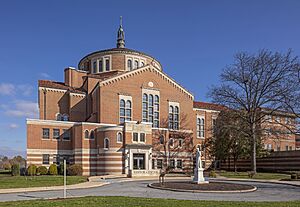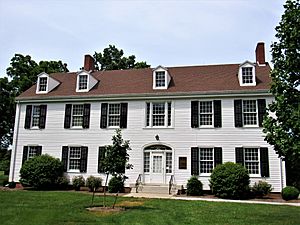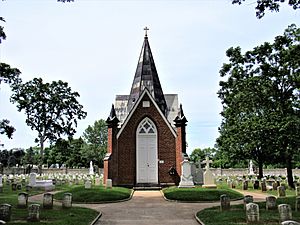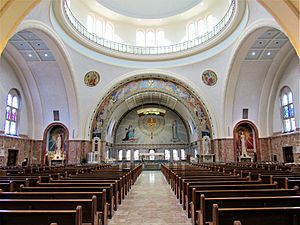National Shrine of St. Elizabeth Ann Seton facts for kids
Quick facts for kids National Shrine ofSaint Elizabeth Ann Seton |
|
|---|---|

The shrine and basilica
|
|
| Religion | |
| Affiliation | Roman Catholic |
| District | Archdiocese of Baltimore |
| Ecclesiastical or organizational status | Minor basilica |
| Location | |
| Location | 339 South Seton Ave Emmitsburg, Maryland, United States |
| Architecture | |
| Completed | 1965 |
| Website | |
| www.setonshrine.org | |
The National Shrine of Saint Elizabeth Ann Seton is a special religious place and learning center in Emmitsburg, Maryland. It honors the life of Elizabeth Ann Seton, who lived from 1774 to 1821. She was the very first person born in the United States to become a saint in the Roman Catholic Church. This important site is known as both a minor basilica and a national shrine.
Contents
The Life of Elizabeth Ann Seton
Early Life and Faith Journey
Elizabeth Ann Bayley Seton was born into a well-known family in New York City. She joined the Roman Catholic faith at Saint Peter's Church in Manhattan on March 14, 1805.
In 1808, Elizabeth was invited to Maryland. She opened a school next to the chapel of St. Mary's Seminary in Baltimore. A wealthy student named Samuel Sutherland Cooper bought a large piece of land near Emmitsburg for a new community of sisters. Elizabeth named this area Saint Joseph's Valley.
Founding the Sisters of Charity
In June 1809, Elizabeth started a group called the Sisters of Charity of St. Joseph. Their first home was an old farmhouse built in 1750, which they called the "Stone House." It was a very cold place, especially in winter. Sometimes, snow would even drift inside the rooms!
In October 1809, Archbishop John Carroll of Baltimore visited. He saw that the Stone House was not suitable. He asked for a new log building to be built. This new building is now called the "White House."
In February 1810, Elizabeth and her companions moved into the new Saint Joseph's House, the White House. Here, she started the first free Catholic school for girls in the United States. This school was the beginning of the Catholic school system we know today.
Mother Seton's Resting Place
Elizabeth Ann Seton, also known as Mother Seton, passed away in January 1821. She was buried in Emmitsburg, in a cemetery she lovingly called "God's Little Acre."
In 1841, Saint Joseph's Chapel was officially opened. The King and Queen of France, Louis-Phillippe and Marie-Amelie, gave three paintings for the new chapel. One of these was a copy of the famous "Assumption" painting by Murillo. The "White House" was later moved to a new spot near the chapel.
In 1846, Mother Seton's body was moved to a special mortuary chapel. This chapel was built in the Sisters' cemetery.
Sisters of Charity During Wartime
During the American Civil War, more than 270 Sisters of Charity worked as nurses. Soldiers from both sides, Union and Confederate, called them "angels of the battlefield." The Sisters also served as nurses during the Spanish–American War.
Exploring the Shrine Complex
The National Shrine of Saint Elizabeth Ann Seton is a place of pilgrimage for many Roman Catholics. It is part of the Archdiocese of Baltimore.
The shrine complex includes several important buildings:
- The Stone House
- The White House
- The cemetery, "God's Little Acre"
- A basilica
- A museum
- The Mortuary Chapel, where Mother Seton's remains were once kept
- A visitors center
The Basilica
The shrine's basilica was completed in 1965. Inside, you can see many beautiful artworks made by skilled artists from Italy and Germany.
Mother Seton became a saint in 1975. After this, her remains were moved from the cemetery to the basilica. In 1991, Pope John Paul II officially named the shrine's chapel a minor basilica. A special ceremony for this took place on August 4, 1991.
Annual Celebrations
Each year, the shrine holds a special event to honor Mother Seton. It celebrates all girls and women named "Elizabeth" and "Elizabeth Ann." These women take part in a procession during Mass. They enter the basilica together, carrying a banner. Two women are chosen to bring flowers to the saint's tomb.
Patroness for the Sea Services
Saint Elizabeth Ann Seton is known as the Patroness for the Sea Services. This is because she cared deeply for her sons, William and Richard. Both of them served in the U.S. Navy. Her many letters to them show how much she worried about them during their time at sea.
The National Shrine hosts an annual Pilgrimage for the Sea Services. Members of the Navy, Marine Corps, Coast Guard, Merchant Marine, and the United States Public Health Service attend. Their families and friends also gather at the basilica in Emmitsburg. This event happens on the first Sunday of October each year. It honors the Patroness for the Sea Services and asks for her help for all the men and women serving our country at sea.
See also
 In Spanish: Santuario Nacional de Santa Isabel Ana Seton para niños
In Spanish: Santuario Nacional de Santa Isabel Ana Seton para niños
- Sisters of Charity Federation in the Vincentian-Setonian Tradition
- Shrine of St. Elizabeth Ann Bayley Seton, Manhattan, New York City






